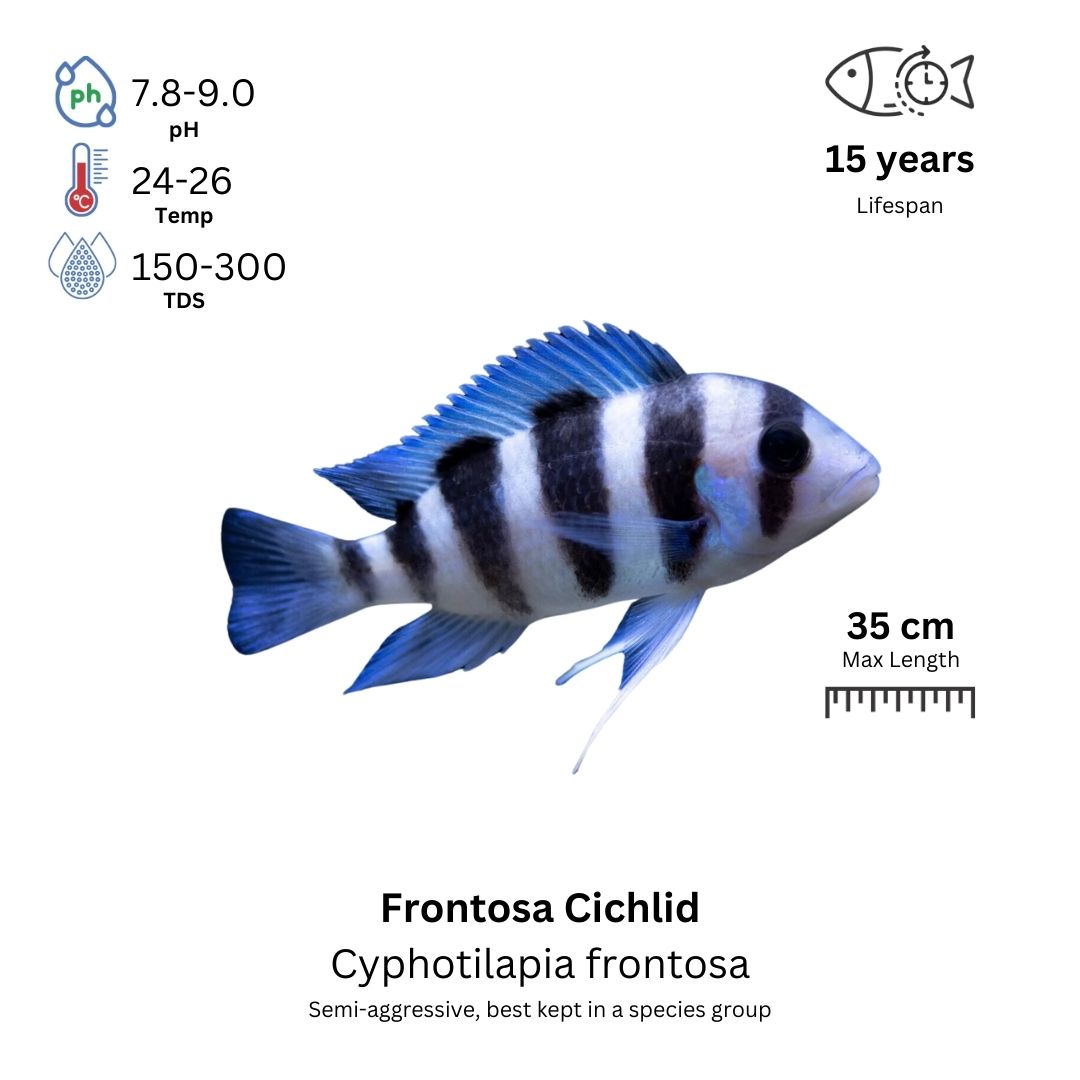Frontosa Cichlid: The Majestic Deepwater Cichlid
Characteristics
The Frontosa Cichlid (Cyphotilapia frontosa) is a large, slow-growing African cichlid admired for its bold vertical stripes, nuchal hump, and regal swimming style. Native to Lake Tanganyika, this cichlid is a favorite among hobbyists who enjoy large, showpiece fish with peaceful yet dominant behavior.
- Scientific Name: Cyphotilapia frontosa
- Common Names: Frontosa, Tanganyika Frontosa, Blue Frontosa
- Natural Habitat: Deep waters of Lake Tanganyika, East Africa
- Behavior: Semi-aggressive, territorial, but relatively peaceful for a cichlid
- Tank Size: Minimum 125 gallons for a small group; larger for colonies
- Ideal Water Parameters:
- pH: 7.8 – 9.0 (alkaline water)
- Hardness: 10 – 20 dGH
- Temperature: 74 – 80°F (23 – 27°C)
- Care Level: Moderate
Origin and Distribution
The Frontosa Cichlid is endemic to Lake Tanganyika, one of the oldest and deepest freshwater lakes in the world. They inhabit deep rocky regions, usually between 15-50 meters (50-165 feet) deep, where they form large social groups (colonies). Due to their slow-growing nature and deepwater habitat, they are best suited for large, stable aquariums.
Colors and Markings
Frontosas are easily recognizable by their:
- Deep blue-to-silver body coloration
- Five to seven bold black vertical stripes
- Large, prominent nuchal hump (more developed in mature males)
- Graceful, elongated dorsal and anal fins
Different regional variants may display slight color differences, such as:
- Burundi Frontosa – Classic six-stripe variety
- Zaire Blue Frontosa – More intense blue coloration
- Tanzania Frontosa – Slightly elongated body with deep contrast
Tankmates
Although Frontosas are cichlids, they are relatively peaceful compared to other African cichlids. They thrive with similar-sized, calm fish. Suitable tankmates include:
- Other Tanganyikan Cichlids (Calvus, Compressiceps, Featherfins)
- Large Synodontis Catfish
- Plecos (Common, Sailfin, Royal Pleco)
- Cyprichromis species (Lake Tanganyika Sardines)
- Medium-sized Arowanas (if tank size allows)
Avoid keeping them with:
- Highly aggressive cichlids (Mbuna, Red Devils, Jaguars)
- Small fish (as they will eventually be eaten)
Care Requirements
Since Frontosas are large, slow-moving cichlids, they need:
- A large tank with plenty of horizontal swimming space
- A sandy or fine gravel substrate
- Rock formations for hiding and territorial boundaries
- Moderate water flow to mimic Lake Tanganyika currents
- High-quality filtration, as they are heavy eaters and produce waste
Perform weekly 20-30% water changes to maintain water stability and prevent nitrate buildup.
Diet and Feeding
Frontosas are carnivorous predators in the wild, primarily feeding on small fish and invertebrates. In captivity, their diet should include:
- High-quality cichlid pellets or sticks (protein-rich)
- Frozen or live foods (krill, shrimp, bloodworms)
- Occasional fresh fish fillets (tilapia, smelt)
- Supplemental greens (spirulina flakes, blanched zucchini)
Avoid feeding them feeder fish, as these may carry parasites and diseases.
Gender Differences
Males and females look similar, but males are generally:
- Larger, with a more pronounced nuchal hump
- More vivid in coloration
- Have slightly longer and more pointed fins
Breeding
Frontosas are maternal mouthbrooders, meaning females hold fertilized eggs in their mouths until the fry hatch.
Breeding Tips:
- Keep a group of 5-7 individuals to allow natural pair bonding.
- Provide flat rocks or caves for spawning sites.
- Males will perform courtship displays, guiding females to a spawning site.
- Females carry eggs in their mouths for 3-4 weeks, during which they eat very little.
- Fry can be fed baby brine shrimp or crushed flakes after hatching.
Breeding Frontosas takes patience, as they mature slowly and may take 2-3 years to reach breeding age.
Additional Resources
For more information on Frontosa care and breeding, check out:
- Beginner’s Guide to Tanganyikan Cichlids
- How to Set Up a Large African Cichlid Aquarium
- Frontosa Tankmate Compatibility Chart
The Frontosa Cichlid is a majestic and rewarding species, perfect for large, well-maintained aquariums. With its distinctive appearance, peaceful temperament, and impressive size, it makes an exceptional showpiece fish for any African cichlid enthusiast!


Reviews
There are no reviews yet.